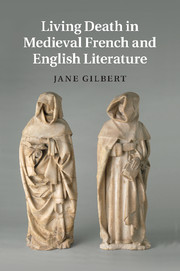Book contents
- Frontmatter
- Contents
- Acknowledgements
- Note on translations
- Introduction: living death
- 1 Roland and the second death
- 2 The knight as Thing: courtly love in the non-cyclic prose Lancelot
- 3 The ubi sunt topos in Middle French: sad stories of the death of kings
- 4 Ceci n'est pas une marguerite: anamorphosis in Pearl
- 5 Becoming woman in Chaucer: on ne naît pas femme, on le devient en mourant
- Conclusion: living dead or dead-in-life?
- Notes
- Bibliography
- Index
- Cambridge Studies in Medieval Literature
Introduction: living death
Published online by Cambridge University Press: 01 March 2011
- Frontmatter
- Contents
- Acknowledgements
- Note on translations
- Introduction: living death
- 1 Roland and the second death
- 2 The knight as Thing: courtly love in the non-cyclic prose Lancelot
- 3 The ubi sunt topos in Middle French: sad stories of the death of kings
- 4 Ceci n'est pas une marguerite: anamorphosis in Pearl
- 5 Becoming woman in Chaucer: on ne naît pas femme, on le devient en mourant
- Conclusion: living dead or dead-in-life?
- Notes
- Bibliography
- Index
- Cambridge Studies in Medieval Literature
Summary
This book is about the ways in which certain medieval literary texts use death, dying and the dead to think about problems relating to life – problems political, social, ethical, philosophical or existential. More specifically, it is about the dynamic interface between life and death and about figures caught at that interface, hence ‘living death’. There are ghosts and revenants who, although dead, actively speak and will, disturbing the properly living. And there are those who while alive exist under a deathly shadow that forecloses their engagement with life and isolates them from their fellows. Vampires, ghosts and zombies are currently fashionable in popular culture; in literary criticism, tropes of the interstitial, the intermediary or the ‘third’ are in vogue. What I have attempted to do in this book is to use some of the latter – in particular, Lacan's notion of l'entre-deux-morts – to think through some medieval examples of phenomena related to the former: dead who return to place demands on the living; living who foresee, organize or desire their own deaths.
LIFE AND DEATH
Death, dying and the dead, as Lévi-Strauss might have said, are good to think with. But surely this assertion is paradoxical? The modern philosophical tradition with which I engage in this book is shaped by Epicurus' affirmation that death ‘is nothing to us; since, when we exist, death is not yet present, and when death is present, then we do not exist’.
- Type
- Chapter
- Information
- Publisher: Cambridge University PressPrint publication year: 2011



